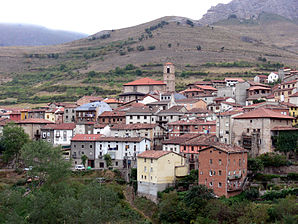Anguiano (La Rioja)
| Anguiano municipality | ||
|---|---|---|
 Anguiano - the townscape
|
||
| coat of arms | Map of Spain | |

|
|
|
| Basic data | ||
| Autonomous Community : |
|
|
| Comarca : | Anguiano | |
| Coordinates | 42 ° 16 ′ N , 2 ° 46 ′ W | |
| Height : | 665 msnm | |
| Area : | 90.89 km² | |
| Residents : | 497 (Jan. 1, 2019) | |
| Population density : | 5.47 inhabitants / km² | |
| Postal code : | 26322 | |
| Municipality number ( INE ): | 26014 | |
| administration | ||
| Website : | Anguiano | |
Anguiano is a place and a municipality ( municipio ) in the southwest of the autonomous community of La Rioja in Spain with 497 inhabitants (at January 1, 2019). The place is also the administrative seat of the comarca of the same name .
location
The place Anguiano is located on a hill above the Río Najerilla at an altitude of about 665 m . The historically significant small town of Nájera is about 20 km (driving distance) north. The distance to the provincial capital Logroño is about 45 km to the northeast. The medieval monastery of San Millán de la Cogolla is approx. 20 km to the northwest. The climate is temperate; Rain (approx. 545 mm / year) falls over the year.
Population development
| year | 1857 | 1900 | 1950 | 2000 | 2017 |
| Residents | 1,515 | 1,676 | 1,664 | 585 | 506 |
As a result of the mechanization of agriculture and the abandonment of small farms and the resulting lower demand for labor, the number of inhabitants has decreased significantly since the middle of the 20th century.
economy
The municipality of Anguiano was and is largely characterized by agriculture. In earlier times, the place served as a handicraft and market center for a few - now mostly abandoned - smaller farmsteads and hamlets in the area. Since the middle of the 20th century, tourism (hiking and holiday homes) has played a not unimportant role as a source of income for the community. The place is also part of the Alta Rioja wine-growing region .
history
Anguiano is first mentioned under the name Anguidano in a document ( fuero ) of King Sancho III. (reg. 1000-1035) mentioned, in which the neighboring town of Nájera certain sovereign rights and liberties are granted. In a further mention from the year 1092, the place, now always called Anguiano, receives grazing rights in the area of the Valvanera Monastery, which today belongs to the municipality. After that the medieval sources are silent. In 1502 the place came under the manorial rule (señorio) of the Valvanera monastery.
Attractions
- Anguiano
- The parish church of San Andrés , a three-aisled and high, but somewhat clunky-looking building, dates from the 16th and 17th centuries. The main attraction inside is a multi-figure wooden altarpiece (retablo) with twisted (“Solomon”) columns from the years 1672–1686.
- Some houses in the village still have heraldic shields made of stone.
- The single-nave church of San Pedro de Cuevas , which stands on a slope below a rock face and appears very defensive , was built in the 15th and 16th centuries. Inside it houses a Romanesque baptismal font and several Baroque altarpieces.
- Also worth seeing is a wash house (lavadero) from the 19th century with its own spring.
- The one-aisled Ermita de Santa María Magdalena , located approx. 1.5 km outside the village, is an outwardly simple-looking building from the 18th century. Inside there is a baroque altarpiece.
- Cuevas
- A 30 m high and 12 m wide single-arched stone bridge from the 18th century (Puente Madre de Dios) spans a ravine of the Río Najerilla and connects the district of Cuevas .
- Immediately next to the Hermit Church is an intermittent spring with a 17th century surround.
- According to a document from the 11th century, the Valvanera Monastery is said to have existed as early as the time of the Visigoth king Leovigild . In the years 1072 and 1092 the kings Sancho IV. And Alfons VI. rich foundations for the benefit of the monastery. As part of the expropriation of church property ( desamortisación ) , the monastery was dissolved in the 1830s, but since the end of the century a small group of monks has lived behind the traditional walls. They produce an allegedly medicinal monastery liqueur (Licor de Valvanera) ; a guest house also helps to finance the monastery. The Gothic church is still largely original; However, large parts of the monastery buildings were restored or renewed in the late 19th century.
Others
A dance on short stilts ( danza de los zancos ) on the day of St. Maria Magdalena (July 22nd), when young men wearing skirts turn in circles and carry the miraculous image up to the hermit church.
Web links
Individual evidence
- ↑ Cifras oficiales de población resultantes de la revisión del Padrón municipal a 1 de enero . Population statistics from the Instituto Nacional de Estadística (population update).
- ↑ Anguiano - climate tables
- ^ Anguiano - population development
- ^ Anguiano - Church of San Andrés
- ^ Anguiano - Puente Madre de Dios
- ↑ Anguiano - Valvanera Monastery
- ^ Anguiano - Walking on stilts







